HTC Sensation 4G Review - A Sensational Smartphone
by Brian Klug on July 1, 2011 12:38 AM EST- Posted in
- Smartphones
- HTC
- Android
- Mobile
- HTC Sensation
- MSM8260
Performance
I’ve been skirting around it for no real reason, but the obvious other big important feature on the Sensation is that it’s the first dual core 45nm snapdragon SoC we’ve looked at in a shipping device. The HTC Sensation is built around a 1.2 GHz Qualcomm MSM8260 SoC with Adreno 220 graphics and integrated Previously, we looked at 3D performance on a 1.5 GHz Qualcomm MSM8660 in a Mobile Development Platform, and briefly in our initial hands on preview piece at Uplinq. There, we saw that performance was about where it should be given the difference in resolution between what we had tested (WVGA - 800x480) and the Sensation’s qHD (960x540) display.
The elephant in the room is what CPU performance on MSM8x60 is like. Dual core snapdragon consists of two scorpion cores clocked at up to 1.5 GHz. Anand is going to give a much deeper CPU architecture dive when he looks at the MSM8660 inside the EVO 3D (again, the x in MSM8x60 merely denotes which modem is onboard), but for now I’m going to present all the benchmark results for the Sensation.
First up are our web benchmarks, which primarily test JavaScript and page rendering. We’re still running SunSpider 0.9, though we’ll soon switch to 0.9.1 and report that alongside. JavaScript performance on HTC’s browser isn’t as good as it should be, and I’m a bit disappointed here that things aren’t better. We’ve seen HTC’s browser result in lower scores before, but it still is at odds with what Qualcomm has told me about how closely the two collaborate to optimize V8 for scorpion.
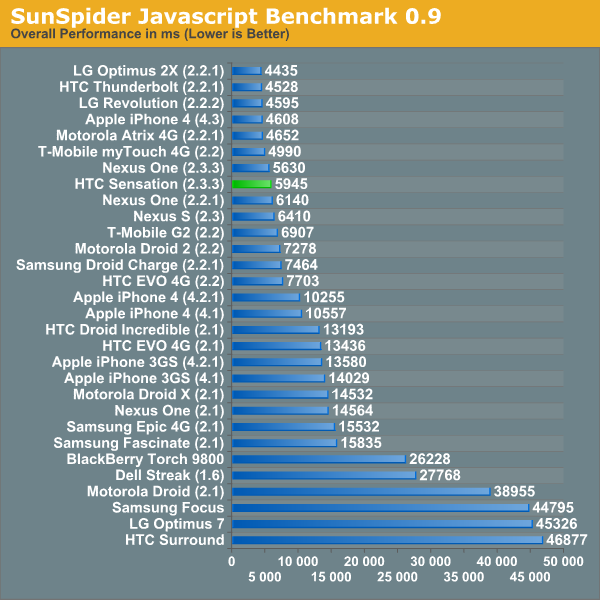
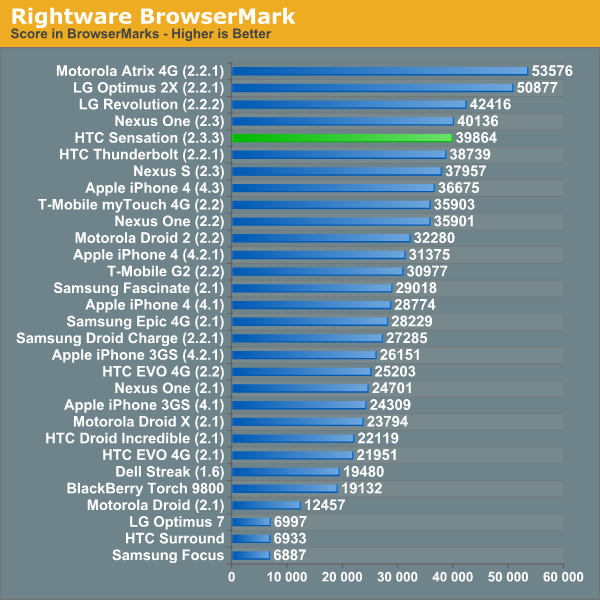
Flash is next, and here the Sensation delivers pretty good performance. It’s hard to make a direct comparison against the Optimus 2X again because we’re dealing with WVGA versus qHD, and we run this test aspect scaled.
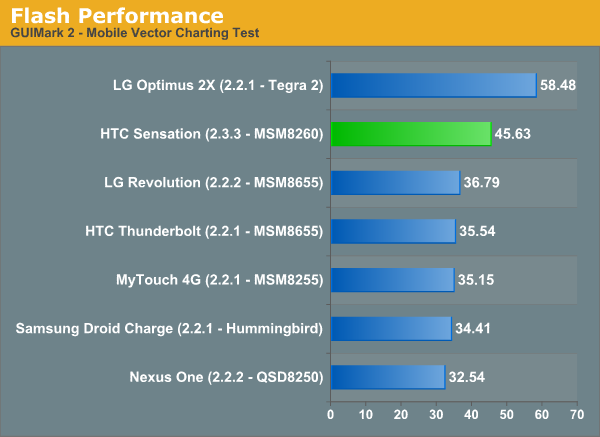
I’m putting Neocore up next because I want to mention again that we’re capped at vsync. We had some hope for a while that we could turn vsync off on handsets, however this is only possible on development hardware, not final ROMs that ship in devices. Odds are you won’t see this pop up again in our suite unless we can make it actually say something. We’re at the Surround’s 60fps wall even at qHD.
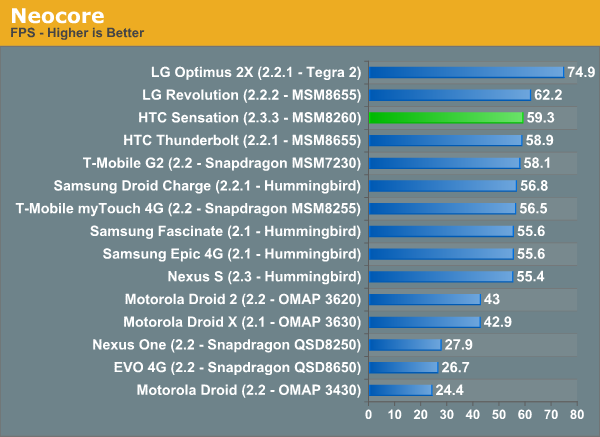
GLBenchmark 2.0 is a mainstay in our benchmarking section, and I’ve already broken down results in our HTC Sensation hands on back at Uplinq. Things have actually improved a bit since that hurried benchmark run over dinner in San Diego, with the Sensation posting around 2fps higher in Egypt and Pro. Again keep in mind the resolution differences between everything here, there’s a 1.35x increase in pixels going from WVGA to qHD.
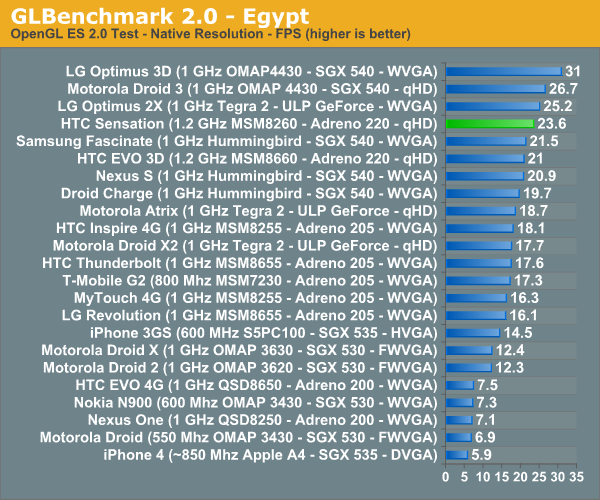
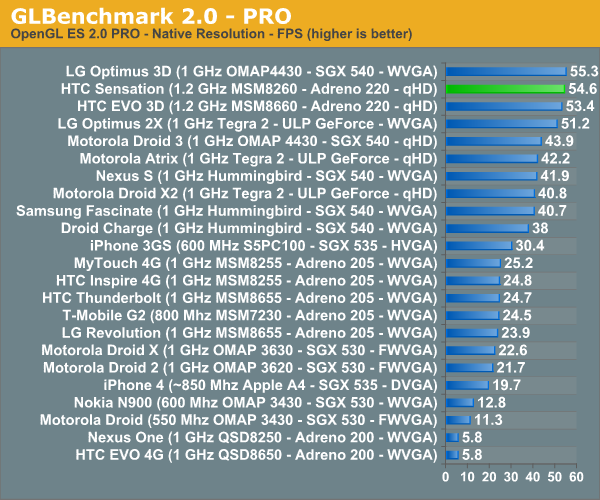
Next is BaseMark ES2.0, which is a nominally updated version of the hugely popular, industry-standard 3DMarkMobile ES2.0. Here we run at the default resolution, which is VGA, and thus get a picture without being constrained to just native resolution constantly. This one is a bit new for us, and I expect that Anand and I are going to explain things a bit more in the EVO 3D story. For now, just take away that MSM8x60 appears very speedy.
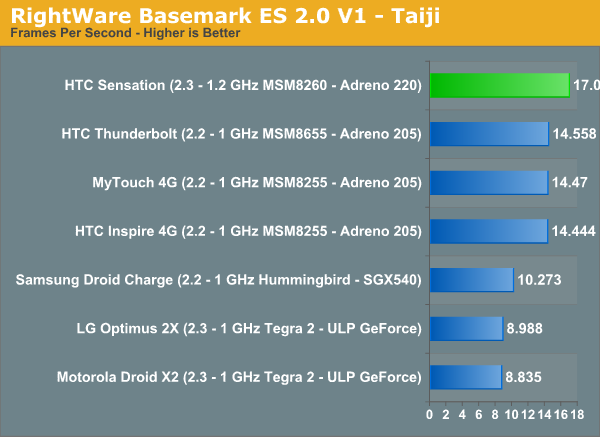
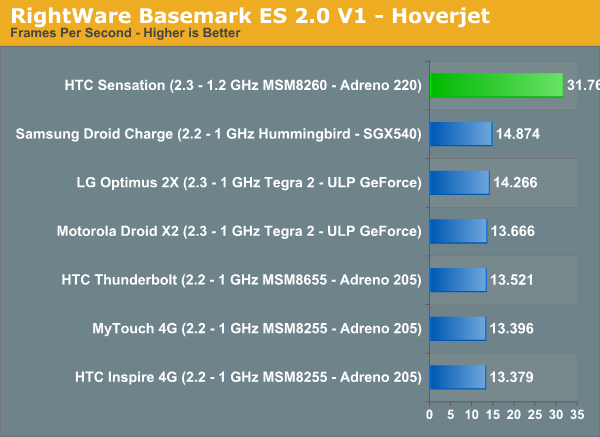
The Android port of Quake 3 is what we sort of started all of this mobile 3D benchmarking with, and we’re still running it even if it’s starting to hit vsync. The results look strange here until you realize that this is again running at native qHD resolution on the Sensation.
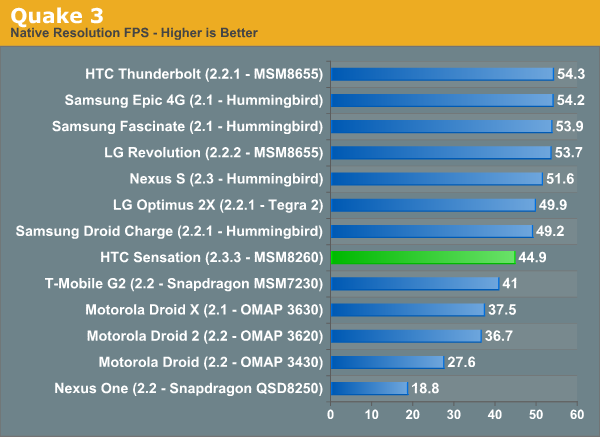
Next up is Linpack, which added a multi-threaded benchmark mode earlier this week. I’ve run it on all the dual core devices I could get my hands on. The initial multi-threaded version had some issues which were fixed on Tuesday, giving more accurate results. We’ll still run the single-threaded version alongside. The 20% jump in clocks shows itself nicely on the Sensation in single-threaded linpack compared to all those 1 GHz MSM8x55 phones we’ve tested.
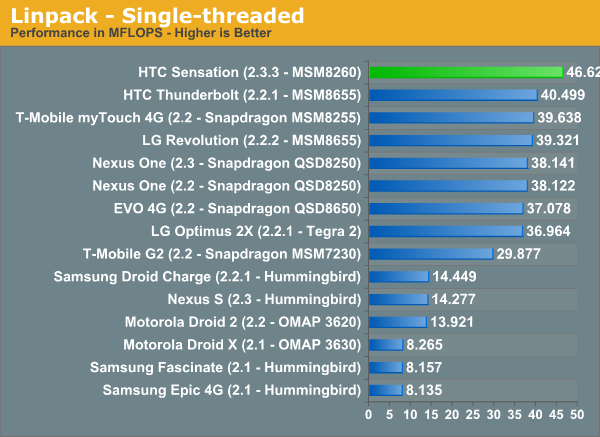
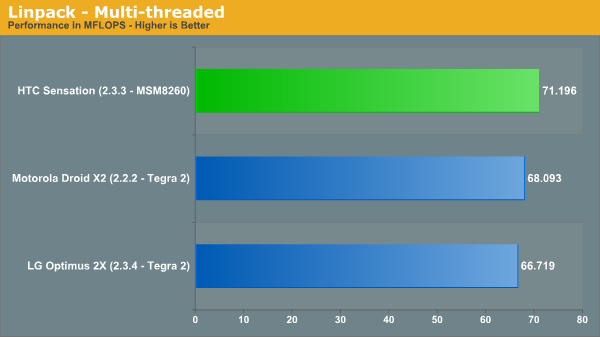
Last and most definitely least is Quadrant, which I think we've gone over our numerous reasons for disliking a few times. The tests themselves are starting to look seriously dated, including 3D tests which render improperly on Android 2.3 and are themselves up against the 60fps vsync cap through their respective runs. I'm sure that the rest of the poorly documented subtests are equally as subpar, however it's become something of a de-facto standard in certain circles.
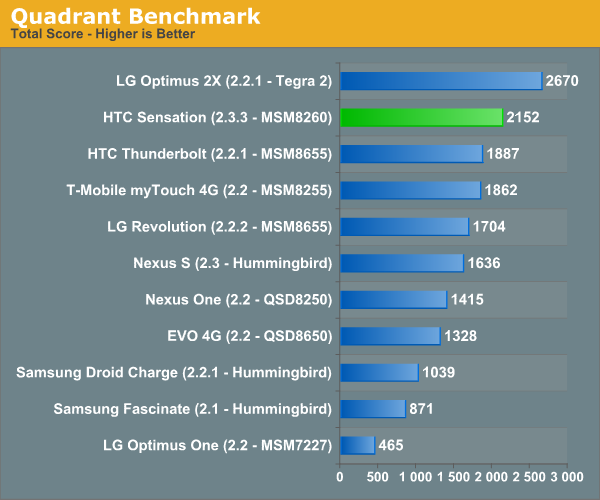
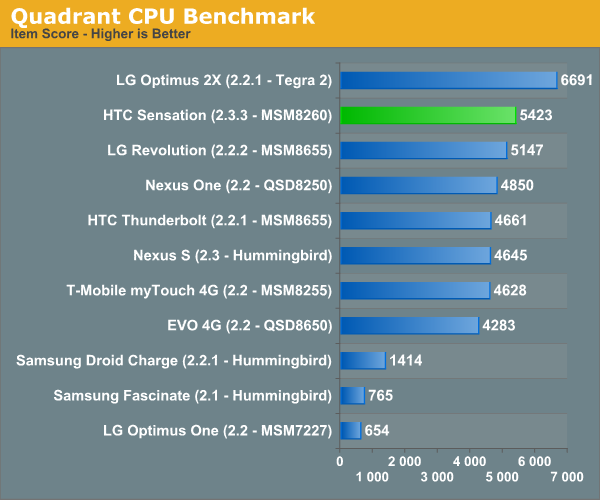
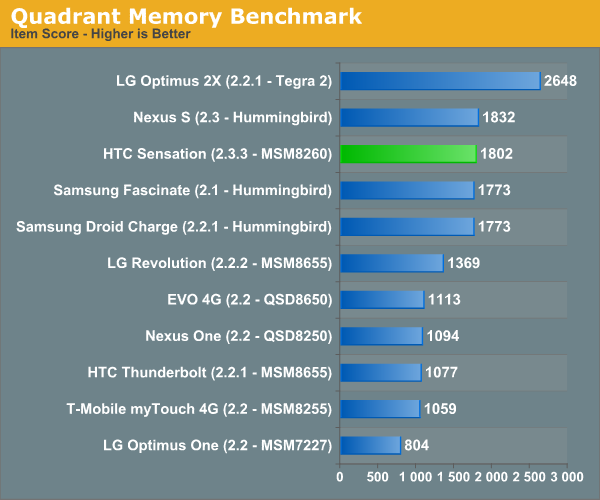
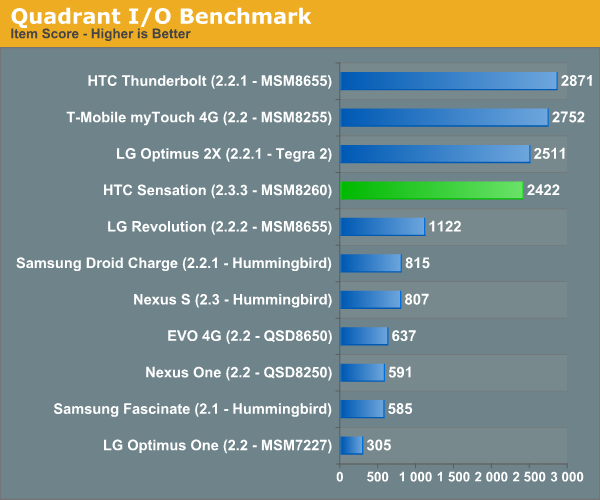
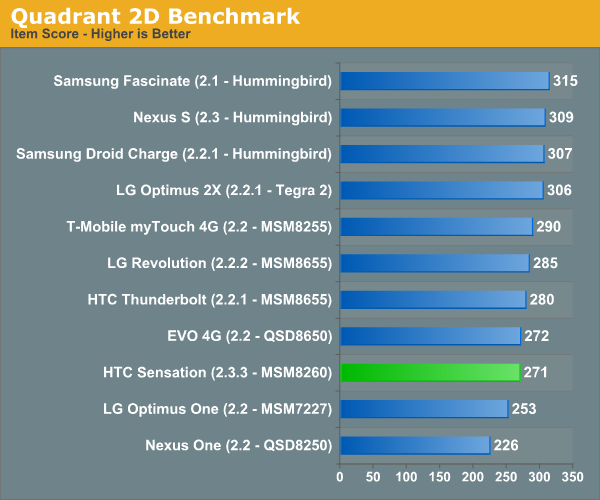
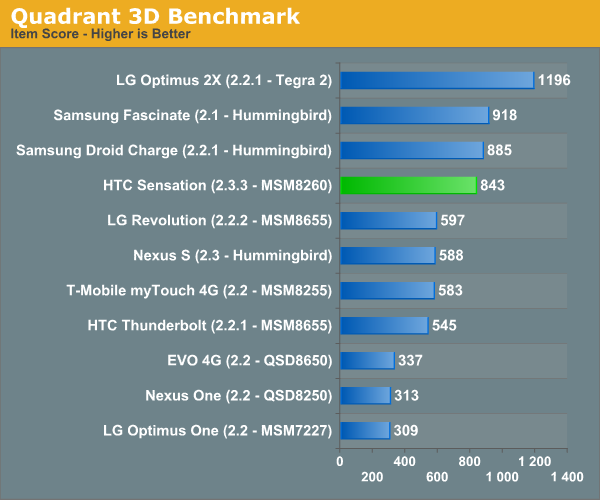
As an aside, I don't think we'll see Quadrant around for much longer, as there are better, more robust, fully documented tools by some established big names coming to the Android market (for free) shortly. All of those will probably quickly and thankfully replace Quadrant, as they all are gunning for its "go-to standard" status as the tool everyone runs, at least from the Android market. I have no doubt they'll quickly succeed.
The state of benchmarking on Android right now is a bit unbalanced, and what everyone wants is a system trace or general use benchmark that will show more than how the CPU does in synthetics and the GPU in synthetics. I fully expect all of that to change this calendar year. Just be patient.










107 Comments
View All Comments
leexgx - Monday, July 4, 2011 - link
but is not 800-900MB not enough space thought with an 8-16-32 SD card as well (i be hard pushed to use 800MB of internal storage) samsung need all that space as they have there own app store that has 3-4 games that use a lot of space, most other phones have 800-900Mb free space nowadays, i guessing most samsung phones do the 2gb/6gb split with 8gb internal spaceif you was talking about cheaper phones like the HTC desire or some random 1.6-2.1 OS phones with 500-800Mhz cpus (that are still been sold what's very lame as they are Crap) i would agree with you 110-50MB of space is not enough even with A2D (that's only on 2.2+ devices)
i agree with the sound of the load speaker seem to be lacking on 2 HTC phones i have seen
samsung need to fix there GPS issues there is Zero reason that GPS should be flaky at best (the jumping between to points every 1-2 seconds)
---------------
i agree GPS should be tested and if the phone has less then 1gb internal storage it should be reported as it makes the phone have limited use
bubblesmoney - Monday, July 4, 2011 - link
Having less internal memory on android phones is actually limitting the number of purchases on the android market. People like me would have probably bought almost all the games by gameloft and many other apps for work. But thats not possible now because of the crap apps 2internal memory policy on android and the equally crap stock app2sd move feature.The microsd cards are ok, but that does not replace the need for proper internal memory. I already have a couple of 4gb cards, a couple 16gb cards and a couple 32gb cards. Would have preffered a hot swappable card feature without needing to pull the batteries. But I guess the USB on the Go feature on the SGS2 is an alternative. My cards are mainly stuffed with office documents and presentations, teaching videos etc apart from a few songs. But still need good internal memory for apps (some games and other professional apps and loads of teaching apps for my child). Presently i am using one phone for me and another for apps for my child. If the internal memory was ok then i wouldnt need to keep switching between two phones depending on what app i want to use. Not everyone is interested in rooting and playing around with firmware. But the present internal memory hardware situation and crap app2sd stock situation doesnt leave one with much alternatives on android for people who need more internal memory.
ph00ny - Wednesday, July 6, 2011 - link
http://img7.imageshack.us/img7/864/sc2011070611392...As for GPS, i've done multiple tests including a tunnel pass and they've been spot on. Walking sessions showed the exact side of the road that i was on (google maps showed accuracy of ~10m) and during the tunnel test, it was able to get gps signal as soon as i was out of the tunnel.
dtomilson - Sunday, July 3, 2011 - link
Let's see some Mango chatter. Let's see a new and innovative mobile OS that has cool new features that no other OS does. Other blogs have raved about it, has Google paid you not to?kmmatney - Sunday, July 3, 2011 - link
I'm still waiting for a good real-life battery assessment for a phone. How long does the battery last if the phone is sitting around doing nothing? Can I squeeze 2 days out of it if I forget my charger on a short business trip? How much charge does it lose sitting on a nightstand overnight? I'm a current iPhone 3GS user, and can get up to 3 days of battery out of my phone if I need to. I have no idea if I can do that just by reading this review.JasonInofuentes - Monday, July 4, 2011 - link
So, battery life assessments are really particular to the user and even down to what day it is. Let's cover your specific questions first.-Battery life sitting around doing nothing: Well, what good is the phone to you if you're not doing anything with it? And, what is nothing? If you mean screen off and not handled (as I'm guessing you mean, does that mean it's also not updating e-mail, and other apps? If you have absolutely no applications periodically pulling data and you leave any of these phones untouched until they die then they will last . . . a really long time.
-2 days on a business trip: What do you do for a living? Again, if you don't have any apps downloading data periodically, you only ever use your phone as a phone and maybe a few e-mail sessions, then any of these phones should hopefully last that long.
-Sitting on a night stand overnight: See the first answer.
Don't look at these battery life measurements as an absolute, look at them as a guide. If you spend a lot of time downloading data on 3G, then make sure to get a phone that does really well in the 3G test. If 3G isn't your thing but you're on WiFi downloading data a lot, then grok the WiFi graph and pick something near the top. And if you're main use for the phone is voice calls, there's a great list of voice call data available to you. Not sure which you are? Well, it sounds like battery life is your bread and butter so just pick one from the top of the list and go for it. You've got at least two weeks to decide if it's for you and my experience is that the honeymoon period when people get new phones is about 5-7 days, at that point they'll either be happy or dragging their charger around with them.
zhongzyk - Monday, July 4, 2011 - link
very good web,believe you will love it.
FREE SHIPPING,accept pyapal
discount including evisu jeans,watches shirts,bags,hat and the decorations
trust me!
Quickly snapping up right
kaikaicc - Tuesday, July 5, 2011 - link
hello,welcome to www. voguecatch us,there have more top goods,like hand bag,t shirt,sun glass and so on ,i hope everyone will like them,thanks
crb119 - Tuesday, July 5, 2011 - link
so is this better than iphone4..........in terms of software avilability...ahat about skype video????.....winst - Wednesday, July 6, 2011 - link
Hello,Why so much emphasis on phone features and such, but little or no information
on the fundamentals , being able to make a decent phone call in various conditions ?
winst